RIP-ROARING COUNTY FAIR RODEO
The stands were packed for the Jasper County Fair Rodeo which featured cowboys and cowgirls on bucking broncos, barrel racing and trying to finish 8 seconds on fired up bulls


The stands were packed for the Jasper County Fair Rodeo which featured cowboys and cowgirls on bucking broncos, barrel racing and trying to finish 8 seconds on fired up bulls

By Christopher Braunschweig Jasper County Tribune
Jasper County Emergency Management Agency announced last week that emergency siren protocols have changed and will go into effect starting July 21. The changes are designed to align the county’s current local alert system with the Wireless Emergency Alerts sent out by the National Weather Service.
It is believed these changes will enhance the timeliness and accuracy of
severe weather notifications in Jasper County.
Jamey Robinson, director of Jasper County EMA, said the alignment with WEA alerts issued by the National Weather Services ensures our warning systems are consistent and that residents receive critical alerts simultaneously. Robinson stressed that sirens are for outdoor notification only.
“When they sound, they indicate that you should immediately seek shelter and tune into local media sources for detailed


System aligns with NWS alerts to enhance timeliness and accuracy
information and instructions,” he said. “Residents are encouraged to familiarize themselves with the new protocol and stay vigilant during severe weather conditions.”
Sirens are activated during these instances: Tornadoes, hail measuring 2.75 inches or larger, winds recorded at more than 80 mph and responder/spotter request. For more information about the changes and how to remain prepared, visit www.jasperema-hls.org or call 641792-7555.
4-H and FFA kids, along with their variety of animals, take over the Jasper County Fairgrounds to show what they have been working on throughout the year




Action will ensure employee’s salary is split evenly by VA and general assistance
By
In an effort to expand the work of and properly certify Jasper County’s shared benefits coordinator, who splits his time between veterans affairs and general assistance, the leader of the Iowa Association of County Commission Veteran Service Officers recommended further assistance from the board of supervisors.
Patty Hamann, president of IACCVSO, told the Jasper County Veterans Affairs Commission during its July 10 meeting that it might be best if supervisors take formal action to adjust the shared benefits coordinator position’s salary so that half comes from veterans affairs and half comes from general assistance.
When human resources director Dennis Simon presented Hamann’s idea to the board during a July 16 work session, there was some initial skepticism from chairman Brandon Talsma, and he suggested whether it was even necessary to take action since the auditor’s office has since handled the budget adjustment.
“Is Patty wanting something in resolution form?” Talsma asked.
Gary Otto Green
July 13, 2024
Gary Otto Green, 77, of Newton died on Saturday, July 13, 2024, at his home. A funeral service will be held at 10:30 a.m., Tuesday, July 23, 2024, at the Wallace Family Funeral Home and Crematory. The fam-
ily will greet friends from 5-7 p.m., Monday, July 22, at the funeral home. Memorials in Gary’s name may be left at the funeral home (checks made payable to Gary D. Green).

Gary, the son of Otto Jay and Mary Elizabeth “Betty” (Schmidt) Green, was born on March 23, 1947 in Newton. He graduated from Newton High School in 1964. Gary served his country in the U.S. Army. On August 8, 1969, Gary was united in marriage with
Penny Alberta Robson in Newton. They moved to Wisconsin for a short time, but then returned to Newton where they always considered home. Gary worked for over 40 years as an engineer for the Vermeer Company in Pella. He was a member of the VFW, American Legion Post111, and the Moose Lodge. He enjoyed NASCAR, fishing, and spending time with his family, especially his grandchildren.
Gary is survived by his children, Gary D. Green
of Marshalltown and Teresa A. (Curt) Robson of Newton; grandchildren, Haley Thompson, Hunter Chamberlin, Brandon Page, and Gage Green; his two great-grandchildren, Nataley and River Thompson; siblings, Gayla (Dave) Hannagan of Newton and Galen (Wanda) Green of Newton; and his two nieces and two nephews. He was preceded in death by his parents; wife, Penny Green; sister, Gloria Clement; and brother, Gil Francis Green.
The American Pickers are excited to return to Iowa. They plan to film episodes of The History Channel hit television series throughout your area in September 2024.
American Pickers is a documentary series that explores the fascinating world of antique “picking” on The History Channel. The hit show follows skilled pickers in the business, as they hunt for America’s most valuable antiques.
They are always excited to find historically significant or rare items, in addition to unforgettable characters and their collections.
As they hit the back roads from coast to coast, the Pickers are on a mission to recycle and rescue forgotten relics.

American Pickers will be looking for different,
Along the way, they want to meet characters with amazing stories and fun items. They hope to give historically significant objects a new lease on life while learning a thing or two about America’s past along the way. The Pickers have seen a lot of rusty gold over the years and are always looking to discover something they’ve never seen before. They are ready to find extraordinary items and hear fascinating tales about them.
items when they travel to Iowa — something
with an extraordinary story.
The American Pickers TV Show is looking for leads and would love to explore your hidden treasure. If you or someone you know has a unique item, story to tell, and is ready to sell … they would love to hear from you. Note, the Pickers DO NOT pick stores, flea mar-
and
kets, malls, auction businesses, museums, or anything open to the public.
If interested, send your name, phone number, location, and description of the collection with photos to: americanpickers@ cineflix.com or call 646-493-2184 or on Facebook @GotAPick.
Theisen’s Home Farm Auto invites nonprofits in its Iowa and Wisconsin store communities to apply for its 2023 More For Your Community grants now through July 31.
The grant program, which is supported by the Theisen’s charitable fund and through a partnership with the Community Foundation of Greater Dubuque, will distribute an estimated $350,000 in funds across the region served by the retailer, with at least $5,000 available to each store community. The maximum request per project application is $5,000. Organizations can apply online at dbqfoundation.org/theisens.
Separate applications are available for organizations applying for a grant at a single location and organizations applying for grants across multiple locations. The deadline to submit applications is 5 p.m. July 31.
The More For Your Community program makes direct grants to organizations to jumpstart and/or sustain projects that effectively and directly serve the basic needs of families and children: food, shelter, education, safety and health.
Applicants must be 501(c)(3) nonprofits, government-sponsored organizations or school-sponsored organizations and directly serve children and families within 60 miles of a Theisen’s store. A full list of Theisen’s store communities is available at dbqfoundation.org/theisens.
“Serving local communities is at the heart of what we do,” Tony Theisen, CEO and president said. “ For more information, contact Gretchen Corcoran, grants manager at the Community Foundation of Greater Dubuque, by calling 563588-2700 or via email at gretchen@dbqfoundation.org.

‘Garden Variety’ and ‘Garden Variety Newsletter’ provide expert insight into
When gardeners have questions — they can get answers — thanks to two popular gardening resources offered by Iowa State University Extension and Outreach and Iowa Public Radio.
“Garden Variety” is the name of a Public Radio podcast based on the Horticulture Day program that runs on Fridays, as part of Talk of Iowa. The program is featured every Friday during the growing season, and every other Friday in the fall and winter.
Each segment features a different gardening topic, with a conversation between host Charity Nebbe and a horticulture expert – mostly from ISU Extension and Outreach.
Gardeners can call in to the Horticulture Day show with their questions and get timely answers. The show is in its 38th year and the podcast is in its third year — with an average of more than 19,000 listeners per month.
“Both programs provide listeners a welcome break from the daily news cycle … a wholly positive, warm community” focused on home gardening, Nebbe said.
“People love to grow things and the experts we bring on the show are so incredibly knowledgeable that even if someone doesn’t have a question, they always learn something,” she said.
National recognition
The Garden Variety program and an accompanying Garden Variety Newsletter were recognized nationally in July, with a silver award from GardenComm — an organization of professional com-

municators in the green and garden industry.
The award recognizes individuals and companies who achieve the highest levels of talent and professionalism in garden communications.
Recipients of the Silver Medal represent the best in their category and will now compete for Gold Medals at the annual awards event, Aug. 28 in Grand Rapids, Michigan.
Aaron Steil, consumer horticulture specialist with ISU Extension and Outreach, said the recognition shows the value of both programs to the public.
“I hear all of the time how much listeners enjoy these programs,” said Steil.
“Some of them set their alarms to remember the air-time, and the feedback tells me they are learning and getting value from tuning in.”
Nebbe said the partnership with ISU Extension and Outreach continues to be a success, and that the horticulture experts who appear on the show are personable and engaging.
“The listeners appreciate the warmth and kindness the specialists bring to people who are asking questions,” Nebbe said. “The experts are excited to talk to people who have questions and educate the audience.

The newsletter is sent to nearly 10,000 subscribers and includes timely tips from horticulture specialists, plus photos and garden success stories from gardeners. For more information, Steil can be reached at 515-294-8953 or ajsteil@ iastate.edu. Ronstik/stock.adobe.com













Simon said, “Not so much resolution but official action on the agenda with a vote yay, nay. That way we have the minutes or something that when feds are going to ask we can say, ‘Yes, the board took official action and this individual is 50-50, and it is out of their (the veterans affairs department) budget.’”
Still, Talsma said he spoke with Sen. Joni Ernst’s team, who told him it was not necessary. Simon suggested taking action would pacify any federal officials and protect Jasper County from government scrutiny. From then on the county could point to the minutes and prove the position is split evenly between two offices.
By proving that Josh Price, the shared benefits coordinator, is an employee of veterans affairs who is compensated from that department’s budget, it would allow him access to trainings to expand upon what he would be allowed to do. He would also report directly to the veterans affairs commission.
Which is similar to how veterans
affairs administrator Alyssa Wilson operates in the office, which is located in the county administration building. Price also would not report to Wilson as a supervisor. Simon said most of Price’s work currently and moving forward is dedicated to the veterans affairs office.
Talsma asked Simon to contact Hermann and ask if a one-time-a-year allocation from the board of supervisors to the veterans affairs commission for 50 percent of Price’s pay and benefits would suffice. Simon explained that the commission still wanted official action on the agenda.
Simon said, “He was hired in as the shared benefits and Connie (McQuiston of general assistance) was his supervisor, and we need something with board approval—”
Talsma interjected, “That says he also answers to the VA commission. OK. Which that’s—“
“Fifty percent VA.”
“I don’t think that’s an issue.”
Originally, Talsma suggested a memorandum of understanding could be drafted that states the position also answers to the veterans affairs commission and spends a minimum of 50 percent or more of his time working with veterans affairs. Simon was not sure



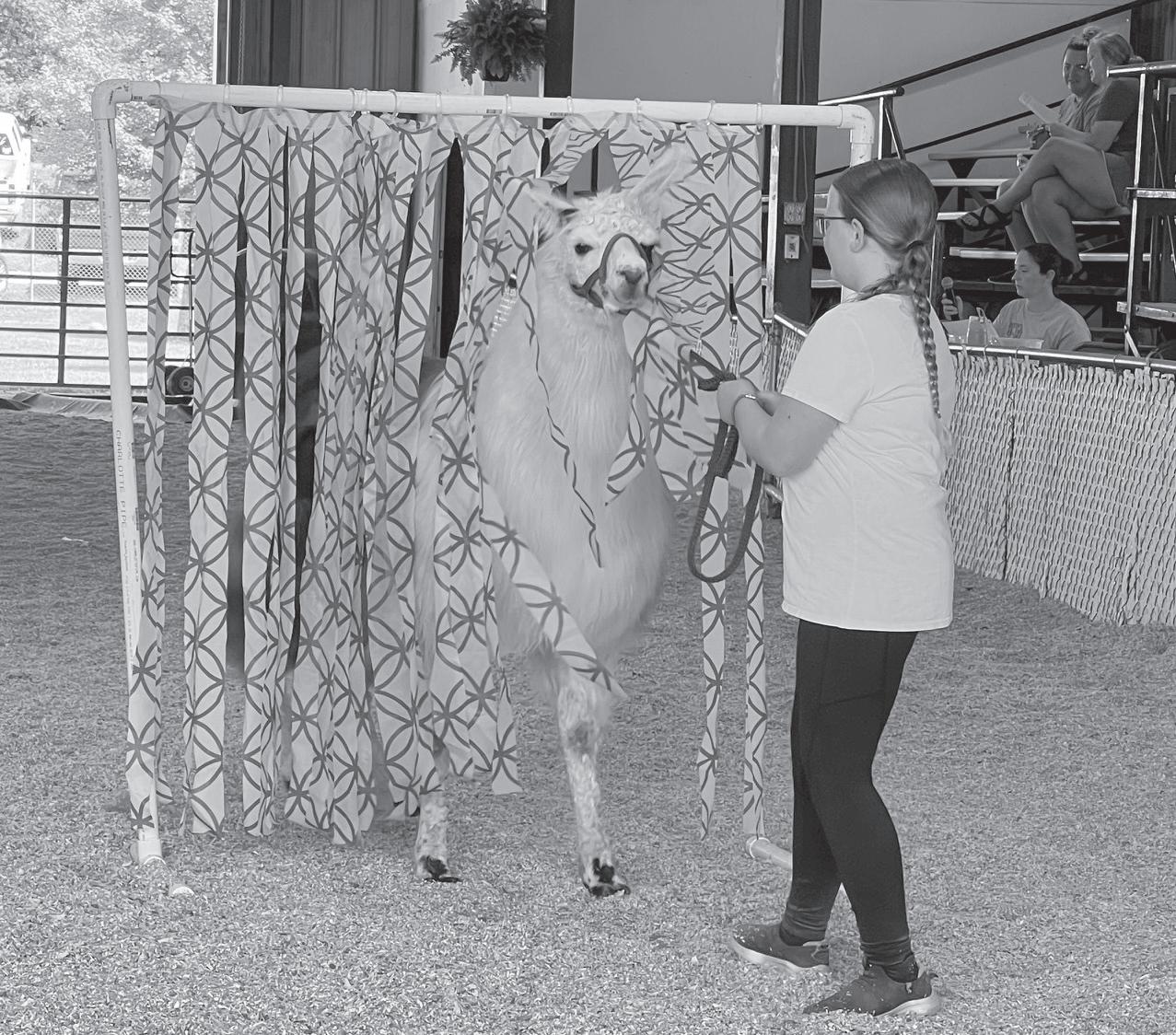


Jasper County needed to go that far.
“We’re going to have the minutes and it’s going to be documented that 50 percent of his salary and benefits will come out of the VA budget,” Simon said. “Because she talked about being able to send those minutes to the feds. So I don’t think we need to make it too complicated. Just an item on there.”
Talsma was on board with the idea but to him it still seemed overly complicated, claiming there are many counties in Iowa with a split position.
For the past few veterans affairs commission meetings, discussions have gotten heated between Wilson, the commissioners and local veterans. One of the recent issues that caused tension was the lack of flexibility with Price’s position and the technicalities that have prevented him from truly taking on extra work.
Veterans have come to Wilson’s defense and said she is overworked, needs more assistance from county supervisors and is limited by what Price can do because his supervisor was the head of general assistance. Hamann’s request helps the latter, but her visit with the commission helped ease other tensions.
While discussion was lengthy and at


times a little chaotic, Hamann offered valuable insight into requirements and accreditations needed for Price and even Wilson to do their jobs properly. Employees of veterans affairs have to maintain a minimum of 20 hours a week, for instance.
“Only county veteran service officers and veterans affairs workers are allowed to get accredited under our national organization,” Hamann said. “…I did a dual role. I, myself, used to be VA and then I did general assistance. I reported to the commissioners on the VA side and I reported to the board of supervisors on GA.”
Commissioner Ed Spangenburg said Iowa Code requires Price to be certified within 12 months of employment. Since Price was hired in February, he asked Hamann if he would have enough time to get his accreditation. Hamann confirmed he still has time so long as he passes the accreditation. But in order to do that, the supervisors would have to make a formal motion acknowledging that he is a 50-50 employee of veterans affairs and general assistance, and that the budget properly reflects that split. As of July 19, the supervisors agenda has included the action for board approval.

















In May 2023, after hearing from small businesses and families across Iowa, the state legislature enacted a new labor law permitting teenagers to work an additional two hours per day — per their choice — during the school year. In addition to allowing reasonable later working hours, the legislation also allows these young Iowans to serve alcohol in restaurants only if they have express, written permission from their parents or guardians and other safeguards.
In addition to empowering young Iowans to learn new skills and save for their future, it affords teenagers of legal working age flexibility during the school year to earn additional money. This commonsense law also helps Iowa small businesses gain relief from worker shortages.

Our District
U.S. Rep.
Mariannette Miller-Meeks
And then, unfortunately, the long arm of D.C. bureaucrats in the Biden-Harris Administration proverbially raided and punished Main Street businesses across Iowa. Without notice, the U.S. Department of Labor (DOL) launched investigations and slapped exorbitant fines on Iowa small businesses for simply abiding by state law.
I am gravely concerned about these bullying acts of enforcement by the DOL. My office has heard from numerous small business owners who
By Thomas L. Knapp
“There is one and only one reason to ever require students to spend time at home mastering what is introduced in class,” libertarian columnist Paul Jacob writes at Common Sense, in criticism of a California bill which might result in reduced homework loads for public school students. “Only to prepare them for earning a living and living life by helping them obtain knowledge and skills and realize their potential.”
I disagree. Unless things have changed since the early 2000s — when my wife and I pulled our own kids out of government schools and switched to homeschooling — the “homework situation” in America is beyond crazy.
As an elementary school student in the 1970s, I could reasonably expect 30-60 minutes of homework per night. That seemed like a lot, but I was a preteen. The workload increased in junior high and high school, but probably still averaged not much more than an hour per day.
By the early 2000s, it wasn’t unusual for my kids’ teachers to send home three hours’ worth of homework per weeknight, or more, and several hours’ worth for weekends.
No, I’m not exaggerating. We were involved parents who helped our kids get through that insane workload.
A workload, I should remind you, that came ON TOP of six to eight hours per day, five days per week, nine months per year, either in school or commuting between school and home.
SPEAK OUT
Almost any adult worker who spent eight hours a day on a factory floor or at an office desk, then was told to work another three hours from home each weeknight and six to eight hours on the weekend, “off the clock,” would seek a salary re-negotiation or quit. The kids don’t get paid, and they’re not allowed to quit.
Also, they’re kids, not adult workers.
Kids need more, not less, sleep than adults. Kids need more, not less, time to play and socialize than adults. And at least some studies show that more than an hour of homework per day correlates with decreased, not enhanced, academic performance.
I’m not normally a “there oughtta be a law” type. In fact, I oppose the government’s “public” education system in its entirety and prefer to see kids homeschooled or privately schooled.
But IF there’s going to be a “public” education system, I favor legally capping that system’s “homework” loads at (for the student of average intelligence) an hour per day in elementary/middle/junior high school, and two hours per day in high school, perhaps with exceptions for “honors” courses, etc.
There’s a term for more homework than that: “Child abuse.”
Yes, education is important. So is kids’ quality of life outside school hours. Leave them some time for their kid stuff.
Thomas L. Knapp is director and senior news analyst at the William Lloyd Garrison Center for Libertarian Advocacy Journalism.
How to contact your elected officials Jasper County Supervisors
Brandon Talsma, chair
4309 W Fourth St. S. Newton, IA 50208
641-526-3142
btalsma@co.jasper.ia.us
Doug Cupples, vice chair 1205 S. 20th Ave. W. Newton, IA 50208 641-521-8725
dcupples@co.jasper.ia.us
Denny Stevenson 110 Railroad Street Kellogg, IA 50135 641-521-8553
dstevenson@co.jasper.ia.us
have been subjected to these investigations and fines.
One small business targeted by the DOL is Sugapeach Chicken and Fish Fry in North Liberty. The restaurant — which gave opportunities to teenagers desiring additional hours of employment — faces a fine of $65,000, threatening its very existence. Some Iowa businesses are threatened by DOL fines up to $180,000.
For 14- and 15-year-olds, federal law states school-year work hours end before 7 and 9 p.m. during the school year and summer, respectively. Iowa’s 2023 law allows for 9 and 11 p.m. respectively, which is a mere two extra hours.
More than 25 states provide greater flexibility than the federal government with night or maximum work hours. This includes states currently led by Republicans and Democrats. Furthermore, Iowa’s work hours have been above the federal maximum for more than half a century.
Why is the Biden-Harris Administration singling out Iowa? Why now?
As Iowa Governor Kim Reynolds
said, we can all agree that the safety, health, well-being and education of our youth is our highest priority.
The DOL’s draconian penalties are a fatal blow to Main Street job creators across Iowa for simply abiding by state law. The Labor Department continues to cling to outdated regulations and listen to those fear-mongering that this new law is akin to putting children in a 19th-century sweatshop. In the Hawkeye State, we are proud to instill the value of dignified work in our younger generations. Regrettably, out-of-touch, paper-pushing bureaucrats 900 miles away in D.C. view this as a negative.
While the entire Iowa Delegation is united in this effort, concerned Iowans should call and email the Department of Labor and the White House to bring attention to this issue.
As your representative in Congress, I will not waver in demanding answers from the Biden-Harris Administration to deliver relief for Iowa families and small businesses whose livelihoods are being threatened by Uncle Sam.
Ingrained in the American spirit is to fight. Fighting for our country, fighting for our values, fighting to leave our home better than we found it.
Last Saturday was another typical weekend during an election year. I went straight from speaking at an event in Burlington and sped over to Mount Pleasant to address another gathering of local Republicans. When I arrived, I was quickly met with someone showing me their phone, live streaming the news about the assassination attempt against President Trump. There were emotional reactions from folks in the room, and murmurs from groups just trying to figure out if he was alive or dead. When I got home, like many Americans, I turned on the news and watched the replay over, and over, and over again of the few
minutes that could have changed the trajectory of American history. The most striking moment was not seeing the assassin’s bullet pierce President Trump’s ear, but his instinct - fight.
You have to think that most people who are shot, or who are in the crosshairs of multiple rounds of gunfire would crawl their way off the stage in whatever fashion they could. Not Trump. Defiantly telling his secret service detail to stop, squeezing his way out of the agent’s body shield, and visibly shaking his fist to the whole world the words that have stuck with many - fight.
Since the age of Trump, myself, along with other Republicans, have at times questioned his unorthodox style of leadership. At times enjoying every bit of it as he dresses down members of the legacy media, and on occasion wishing he could show some discretion on social media. However, I have come to see something in President Trump I never have before;
fore. Whatever happened to just slapping a bumper sticker on your car and that was it?
the fighter we need at this moment in American history.
As we look across the world, we see utter chaos on Joe Biden’s watch. A war that should have never started in Europe, Hamas terrorists brazenly killing innocent Israeli citizens and a Chinese Communist Party that has openly advertised their intent to invade Taiwan. Our adversaries who once stood down to President Trump are now empowered under President Biden.
Weakness emboldens our enemies, but strength keeps them at bay. This November we have a choice between a weak and feeble leader, who not only fails to display strength abroad but can’t even carry himself up the steps of Air Force One. On the other hand, we have a leader who stood to his feet with blood dripping down his face, to tell America’s enemies that we will not fall, and reminded Americans of the strength we still have.
Rep. Taylor Collins Iowa House District 95
to go about improving roads and schools and workplace safety and having better access to healthcare?
In light of recent horrific events, I have one wish. That wish is for politics to become boring again. In the last decade and a half, our politics have gone from being mostly boring debates about policy issues to becoming more like violent sporting events where everyone has a team and the opponent is to be defeated at all costs. Heck, we even buy more and more political team gear now to wear and display at our homes and on our vehicles like never be-
SHARE YOUR VIEW
Now, everyone has access to cable news and social media, of which, in my opinion, about 99 percent is pure garbage. Turn on any cable channel, open up X or Facebook, or the other internet sites, and you are bombarded with the nastiest, most ridiculous mess of misinformation, lies and conspiracies imaginable. Most people recognize it as the nonsense it is, but too many believe it, share it and live their lives around it.
How about we just stop the madness and go back to arguing about boring tax policies and how
How about we stop making cable news and social media the focal points of our days and go back to talking about the weather, or anything besides politics?
I’m tired of feeling compelled to pick a side and cheer for one team over another and demonizing the other team and its fans. Aren’t we all fed up and exhausted with talking politics all the time with everyone we know?
Yes, boring sure would be nice for a change, wouldn’t it?
John Moore Newton
Letters to the Jasper County Tribune will be edited for libel, grammar and length and should not exceed 400 words. We reserve the right to shorten letters and reject those deemed libelous, in poor taste or of a personal nature. Include your full name, address and a daytime phone number for verification. Signed columns as well as letters to the editor and editorial cartoons represent the personal opinion of the writer or artist.
Submit letters to news@jaspercountytribune.com or Newton News, P.O. Box 967, Newton, Iowa 50208.
Submitted Photo

The American Legion of Iowa Foundation presented Jasper County RSVP with a check for $1,600 to be put toward the Jasper County Ride Program. Jasper County Ride is a medical transportation program free for qualified applicants. The drivers are all RSVP volunteers and the Ride program coordinator is Jasmine Bailey. Pictured are Steve Dix from the American Legion Foundation and Sarah Patterson, Jasper County RSVP director. The RSVP Ride program is proud to assist veterans and others in Jasper County.
Learn more about buying sweet corn, keeping it fresh and growing your own
The middle of summer is officially here and so is sweet corn season. With the unusual weather events this year, Iowans can still expect to see an abundance of their favorite sweet corn variety. Iowans in the southeast witnessed their first round of sweet corn on June 24. Four days later, producers were back in the fields harvesting larger amounts. In central Iowa, growers saw their share start trickling out of fields as of July 4.
In this article, Dan Fillius, field specialist for horticulture and commercial vegetables with Iowa State University Extension and Outreach, shares his insight on some basic sweet corn questions. When is sweet corn the best?
In most years, Iowans can buy local sweet corn from roadside stands before it is available in stores. Sweetcorn being sold from the back of a truck bed has most likely been picked that same morning – making it exceptionally fresh and the best for supper that night!
Husking an ear of sweet corn, by Elena_Alex/stock.adobe.comWhen choosing your corn from the grocery store, the question of when it was picked is more complex. The kind of sweet corn available at grocery stores is either picked fresh daily with a new delivery every day from a local Iowa farm, or it is a supersweet variety that is going to hold its value for a week to 10 days.
“The corn that is in the grocery stores nowadays typically does not
lose its quality for at least a week,” said Fillius. “It could be shipped from Florida during the off-season and many would be surprised to learn that it will still hold its flavor throughout transport. Supersweet corn can be picked and kept cool and still last a week to 10 days.”
The overall best option is to eat your sweet corn on the day of purchase. However, the sweeter the sweet corn variety, the longer it will keep without degrading. When should I harvest sweet corn?
Sweet corn should be harvested at the milk stage. At this stage, the silks are brown and dry at the ear tip. When punctured with a thumbnail, the soft kernels produce a milky juice.
Overmature sweet corn is tough and doughy. An immature ear is not filled to the tip, and the kernels produce a clear, watery liquid when punctured. The harvest date can be estimated by noting the date of silk emergence. The number of days from silk emergence to harvest is approximately 18 to 23 days.
Prime maturity, however, may be reached in 15 days or less if day or night temperatures are exceptionally warm. Most hybrid sweet corn varieties produce two ears per plant. The upper ear usually matures one or two days before the lower ear. Lower ears are just as tasty as upper ears, however they are almost always smaller, making them less marketable for commercial producers.
How to keep your sweet corn fresh?
To prolong the life of your sweet corn, make sure to keep your ears cold and stored in the refrigerator. If your sweet corn is warm, the sugar is going to degrade faster, and the taste will not be as fresh. Also, be on the lookout for corn earworm. While you may be tempted to discard ears that have obvious worm damage, early season sweet corn this year is likely to have more worms than usual. Fillius said that Iowa farmers struggled with ear worm and other pests this year because of the unusual amount of rain and heat. Ears of sweet corn.
Remember Peaches and Cream? Peaches and Cream is a common marketing term for bicolor sweet corn describing the yellow and white kernels. There used to be a popular variety named ‘Peaches and Cream’ that was grown and very popular, but it is not grown as much anymore.
Most of Iowa’s sweet corn today is not truly ‘Peaches and Cream,’ but rather this evocative term has turned into a local understanding of the sweetness one finds in delicious, bicolor Iowa sweet corn.
Grow your own sweet corn
Learn more about growing sweet corn in a recent Yard and Garden article called Growing Sweet Corn in the Home Garden. Additional information is available in a recent edition of Talk of Iowa, a show produced by Iowa Public Radio.
Send items to news@jaspercountytribune.com
THURSDAY • AMVETS meets at 7 p.m. the fourth Thursday of month at the Colfax Fire Station. • Mingo Park & Recreation regular meeting meets at 6:30 p.m. the last Thursday of month at City Hall
SUNDAY
• Colfax Historical Society Museum is open from 2 to 4 p.m. every Sunday through Labor Day.
MONDAY
• C-M Food Pantry meets at 6:30 p.m. the last Monday of month at the Food Pantry • Colfax Park Board meets at 6 p.m. the last Monday of month in the library meeting room
Pikes Peak State Park and 2 other locations voted the top hidden gem picnic spots in Iowa
Poll reveals the top 125 off grid locations for your next outdoor adventure
July is National Picnic Month, and the U.S. is teeming with incredible picnic spots perfect for summer. Iconic locations like Central Park in NYC offer lush greenery, scenic views, and vibrant city energy, from the Great Lawn to Sheep Meadow. Similarly, Golden Gate Park in San Francisco boasts diverse and beautiful picnic areas, such as the Conservatory of Flowers, Stow Lake, and the meadows near the de Young Museum.
However, beyond these well-known destinations, there are hidden gem spots that only locals know about. Mixbook commissioned a survey involving 3,000 respondents to uncover and rank the ultimate offthe-radar picnic spots across America.
Iowa has three locations included in the top 125 picnic spots: #39 Pikes Peak State Park, McGregor
This park offers stunning views of the

Mississippi River and has many secluded picnic spots along its trails. The combination of river views and wooded areas provides a picturesque picnic setting.
#42 Ledges State Park, Madrid Ledges State Park is known for its dramatic sandstone cliffs and quiet picnic areas. The park’s unique landscapes and serene environment make it a great spot for a relaxing picnic.
#96 Gray’s Lake Park, Des Moines Gray’s Lake Park is an urban oasis with quiet picnic spots along the lakeshore, walking trails, and beautiful views of the Des Moines skyline. It’s a convenient location for a city picnic.
HOWARD ST. CHRISTIAN CHURCH (Disciples of Christ)
Pastor Tom Burns Howard & Locust St., Colfax Office - 674-3746 Church Cell - 971-0569
SUNDAY - 9 a.m. Adult & Wired
Word Adult Sunday school classes; 10 a.m. Fellowship
Time;10:30 a.m. Worship, in person or online via YouTube
MONDAY - Tom’s day off
TUESDAY - 9:30 a.m. Coffee
Time/Fellowship; 2 p.m. Easy Yoga
WEDNESDAY - 3:30 p.m. After school elementary youth; 6:10 ChiRho and CYF youth supper/ youth group
THIRD SUNDAY of month
- Marathon Sunday includes elders, board, potluck and food pantry
FIRST MONDAY of monthWIC appointments
IRA UNITED CHURCH
Rev. Michael Omundson
METZ COMMUNITY CHURCH
3253 W. 62nd St. S., Newton Pastor David Rex 641-521-4354
SUNDAY - 9 a.m. Sunday school; 10:10 a.m. Worship Last Saturday of month - 8 a.m. Men’s Breakfast
FIRST BAPTIST CHURCH Colfax Minister, Pastor Cody Dyer Church Office 674-4165
SUNDAY, July 28 - 9 a.m. Fellowship; 9:15 a.m. Bible Education Classes; 10:25 a.m. Message by Pastor Cody Dyer
TUESDAY, July 30 - 3:30 p.m.
Women’s Prayer and Coffee; 6 p.m. Trustee meeting
WEDNESDAY, July 31- 9 a.m.
Busy Bee Quilters and Fresh Encounter Prayer
SATURDAY, Aug. 3 - 7:30 a.m.
SUNDAY - 9:30 a.m. Church service; 10:15 a.m. Sunday school (communion first Sunday)
The
Men’s Breakfast/Bible Study; 9 a.m. Women’s Ministry
SACRED HEART CATHOLIC CHURCH
Newton, Iowa
SATURDAY - 4 p.m. Mass
SUNDAY - 9 a.m. Mass
COLFAX FIRST UNITED
METHODIST CHURCH
S. Locust & W. Division St. Office - 674-3782
Rev. Phil Dicks pastor
SUNDAY - 10:30 a.m. Sunday School; Family Worship
MONDAY - WEDNESDAY, July 29 – 31 Bible School
HOPE ASSEMBLY OF GOD
126 E. Howard Rev. Paul Avery, pastor Church: 674-3700 hopeassemblyofgod@yahoo.com
SUNDAY - 9 a.m. Sunday school; 10 a.m. Worship
WEDNESDAY - 7 p.m. Evening Service
IMMACULATE CONCEPTION
CATHOLIC CHURCH
302 E. Howard St., Colfax Fr. Ron Hodges
515-674-3711
SUNDAY - 9 a.m. Mass
DAILY MASS - 8 a.m.
MINGO UNITED METHODIST CHURCH
Rev. Phil Dicks
515-689-4926
SUNDAY - 9 a.m. Worship ser-
vice (Sunday school not meeting at this time)
ASHTON CHAPEL
8887 W. 122nd St. N., Mingo
Pastors: Larry Craig & Mark Eddy
SUNDAY - 9 a.m. Sunday school; 10 a.m. Worship
BETHANY UNITED CHURCH OF CHRIST 5627 N. 95th Ave. W., Baxter 641-227-3402
Pastor Chris Hayward
SUNDAY - 9 a.m. Sunday School (Sunday after Labor Day to second Sunday in May); 10 a.m. Sunday Worship. First Sunday communion. All are welcome. baxterbethanyucc.org
EVANGELICAL FREE CHURCH BAXTER
Mike Mclintock, Pastor
SUNDAY - 9:15 a.m. Sunday School; 10 a.m. Worship; 6 p.m. Awanas
WEDNESDAYS - 1st & 3rd6:30 p.m. Mens Bible Study 2nd & 4th - 6:30 p.m. Men’s and Womens Bible Study
THURSDAYS 10 a.m. - Womens Bible Study
BAXTER CONGREGATIONAL CHURCH
218 S. Main, Baxter
Pastor Ben Spera Church: 641-227-3382
SUNDAY - 10 a.m. Worship
WEDNESDAY - 6 p.m. Bible Study
THIRD THURSDAY of month - 6:30 p.m. Theology on Tap at Bea’s Place on Main Street Check us out on Facebook and baxtercongregational.com
CORNERSTONE BIBLE FELLOWSHIP
1000 E. 12th St., Newton Rev. Josh Farver, pastor Phone 641-792-4650
SUNDAY - 9 a.m. Sunday school; 10:15 a.m. Worship
WEDNESDAY - 6:30 p.m. Prayer Meeting and Bible Study; Youth Group
HERITAGE WORD OF LIFE
ASSEMBLY OF GOD 102 Second St. NW, Mitchellville Pastor Dave Adams 515-967-3330
SUNDAY - 9 a.m. Bible classes; 10 a.m. Worship service; 6 p.m. Evening service WEDNESDAY - 7 p.m. Evening activities
LUTHERAN CHURCH OF HOPE Capitol II Theatre in Newton SUNDAY - 9:30 a.m. Livestream Worship Service



























































Exercise is widely recognized as a vital component of a healthy lifestyle. Despite that, a recent analysis of data from the 2020 National Health Interview Survey found that more than two-thirds of individuals are not getting enough exercise. Though the survey was conducted amid the onset of the COVID-19 pandemic, which suggests the overall figures might be somewhat lower than they might have been had the data been collected in a more typical year, just 28 percent of respondents were meeting the physical activity guidelines established by the Centers for Disease Control and Prevention.
Routine exercise is beneficial for people of all ages, and seniors are no exception. Aging adults who want to be more physically active but think they are among the 72 percent of individuals who aren’t meeting CDC exercise guidelines can speak with their physicians and ask
these three questions to ensure the transition to a less sedentary lifestyle goes smoothly.
1. Should I get a heart checkup?
Doctors may already be monitoring aging individuals’ hearts even if they have not exhibited symptoms of heart problems in the past. However, it’s best to discuss heart health in greater detail prior to beginning a new fitness regimen. In an interview with Penn Medicine, Neel Chokshi, MD, MBA, medical director of Penn Sports Cardiology and Fitness Program, noted the risk of heart attack or cardiac complications slightly increases when individuals begin to participate in a moderate or intense activity. So a physician might want to conduct a heart checkup in order to determine if a patient has an underlying heart condition.
2. Which types of activities should I
look to?
A physician also can recommend certain activities depending on a person’s age and medical background. Though exercise is beneficial for everyone, certain activities may not be. For example, AdventHealth notes that high-impact activities like jogging and jump rope may not be suited for individuals with arthritis. In addition, aging individuals with physical limitations that require them to use a wheelchair should not write off their ability to exercise, as physicians can recommend exercises for patients with mobility issues as well.
3. Should I take extra caution while on medication?
Prescription medication use is another variable that must be taken into consideration before beginning a new exercise regimen. The CDC notes that roughly 84 percent of adults between the
ages of 60 and 79 use one or more prescription medications. Each medication produces different effects, and a 2016 study published in the Methodist DeBakey Cardiovascular Journal noted that certain medications evoke an acute drop in blood pressure, which can disturb balance and increase fall risk, while others actually facilitate greater improvements in health outcomes. That means the dynamic between medications and exercise is unique to each medication, which underscores the importance of speaking with a physician whenever a fitness regimen is started or tweaked and/or a new medication is prescribed.
These are just three of the questions seniors can ask when discussing exercise with their physicians. Seniors are urged to ask any additional questions they might have during such discussions. — Metro Creative
Pickleball has inspired millions of devotees. According to the Association of Pickleball Professionals, roughly 36.5 million individuals played pickleball in 2022, and 45 percent of players who participated in a YouGov study conducted between August 2021 and August 2022 indicated they planned to play more pickleball in the coming six months than they had in the previous six months.
Pickleball is thriving, and that’s great news for those who love the game. Unfortunately, pickleball also has proven beneficial to orthopedic practices. A 2023 analysis from UBS estimated pickleball injuries could cost Americans nearly $400 million in 2023. Seniors are especially vulnerable to pickleball injuries, as a 2021 study published in the journal Injury Epidemiology found that 86 percent of emergency room visits related to pickleball injuries affected individuals 60 and older.
Injuries are a part of any sport, and pickleball is no different. Though there’s no foolproof method to guarantee pickleball players don’t get
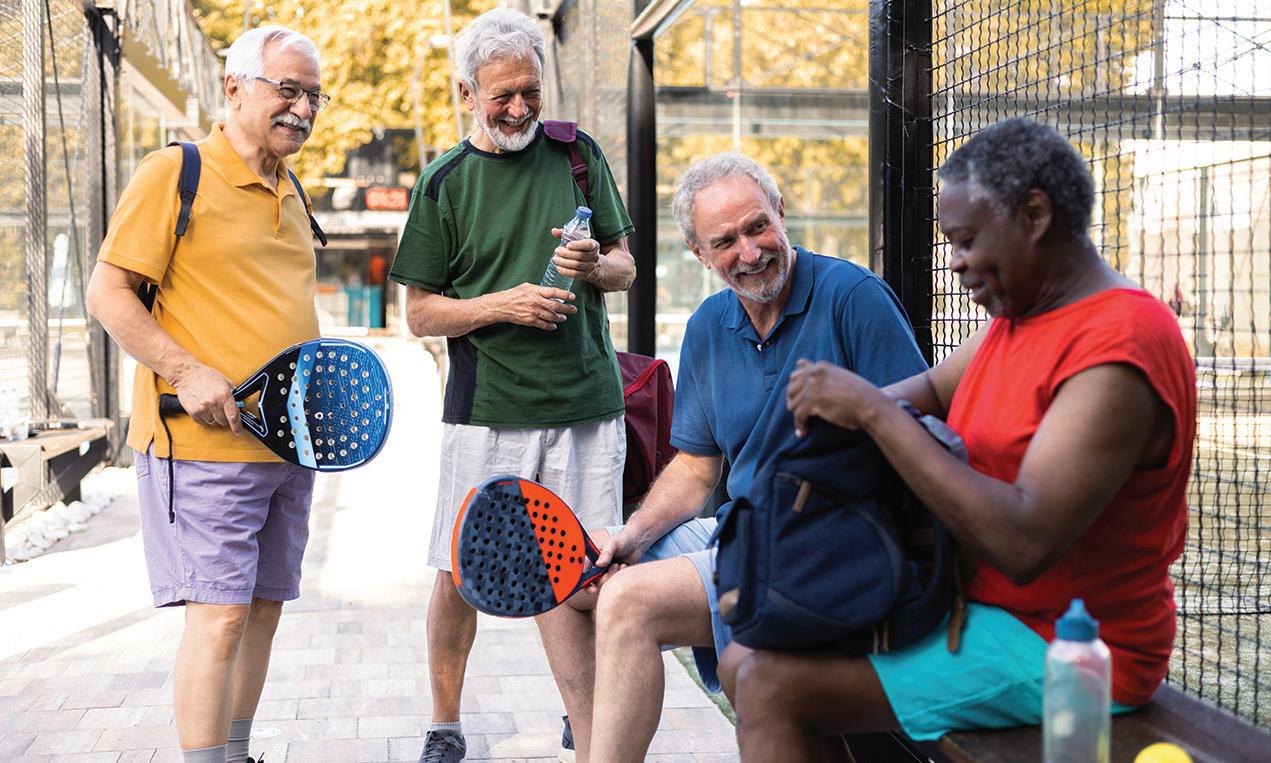
hurt playing the game they love, the following are some tips that can reduce injury risk. • Gear up. Pickleball is a competitive sport, but there’s a tendency among some players, particularly novices, to take a casual approach to the game.
Veteran players may know better, but anyone new to the game should be sure to wear the appropriate gear when playing. Athletic shoes with ample traction can reduce the
likelihood that players will slip or fall. The right racket also can reduce risk for elbow injuries. The sporting goods experts at Dick’s Sporting Goods note that paddles should feature a light to medium weight, comfortable grip and a large sweet spot. The right paddle will be different for everyone, so novices are urged to speak to veteran players for advice on which paddle might be best for them.
• Embrace physical activity.
Pickleball can be a great workout, and players can reduce their injury risk by embracing physical activity even when they are not playing. Leg exercises can help build lower body strength, but strength exercises that focus on the upper body also can reduce injury risk.
• Loosen up before playing.
Taking the court right after getting out of the car is a recipe for injury. Arrive five to 10 min-
utes before a game and use that time to loosen up. A short walk and some subsequent stretches can help players make sure their bodies are not too tight to play. Some brief warm-up exercises and stretching can reduce muscle tension and make the body less vulnerable to injury.
• Hydrate before, during and after a game. The experts at Johns Hopkins Medicine note that water cushions the joints, which helps athletes maintain their flexibility. Flexibility can reduce injury risk, particularly in a sport like pickleball. The 2021 study published in Injury Epidemiology noted that 60 percent of pickleball injuries are sprains, strains or fractures. Remaining flexible can reduce athletes’ risk for sprains and strains. Johns Hopkins recommends adults consume between six and 12 ounces of water for every 20 minutes of sports play and to drink between 16 and 24 ounces afterward.
Pickleball is wildly popular, even though pickleball injuries are common. Players can embrace various strategies to reduce their injury risk.
— Metro Creative
Arthritis isn’t a single disease, but a term that refers to more than 100 conditions characterized by joint pain or joint disease, says the Arthritis Foundation. Arthritis is the leading cause of disability in the United States, and affects women at a proportionally higher rate than men.
Arthritis looks and feels different to the various people who experience it, and symptoms can vary from day to day depending on variables such as the weather and individuals’ level of physical activity. When arthritis flares up, it can make performance of daily activities challenging. Therefore, people experiencing arthritis can take steps to make living with the condition somewhat easier.
Work with an occupational therapist
An occupational therapist can assess work and home situations and make recommendations on potential modifications to these spaces that might be right for your situation. The bathroom and kitchen typically are two spaces where people spend a lot of time and can be areas of focus. Having items at counter height; purchasing smaller sizes of products that are easier to hold; avoiding bending down by using a grabber tool; and having a chair or stool nearby so that you can sit while doing an activity can help.
Use smart devices
The bevy of smart devices now available can work to your advantage. With the push of a button on a phone app or through voice control, you can turn on lights, switch the thermostat or perform any other tasks programmed around the house. This can help when mobility is compromised.
Focus on kitchen tasks
Meal preparation can be a chore when arthritis makes it painful. Rather than eating out all of the time, some tips can help. Utilize frozen fruit or vegetables that already are chopped and prepared to cut down on these tasks. Invest in lightweight cookware and dishes to simplify moving items around. Electric jar openers, kitchen scissors and even vegetable steamers that require less water are additional kitchen tools that can make life with arthritis a little easier.
Move your bedroom
If climbing stairs repeatedly is problematic, move clothing or even your bedroom downstairs to reduce trips up and down. Additional relocation techniques can include putting a mini fridge in your bedroom or relocating the washer and dryer upstairs to make laundry easier.
Get a rollator
A rollator is a wheeled walker that doubles as a seat. It provides support when walking, but also can be a comfortable place to stop and take a seated break.
Get the right pain relief
Pain relief can make it easier to cope. Strategies include anti-inflammatory medications, physical therapy and massages, stretching and exercising, and even prescription therapies that target the immune system in people with autoimmune arthritis. Work with health professionals to get the right combination of what is needed to alleviate pain and stiffness. Arthritis affects millions of individuals around the world. By making some changes, people living with the condition can find life a little bit easier.
— Metro Creative
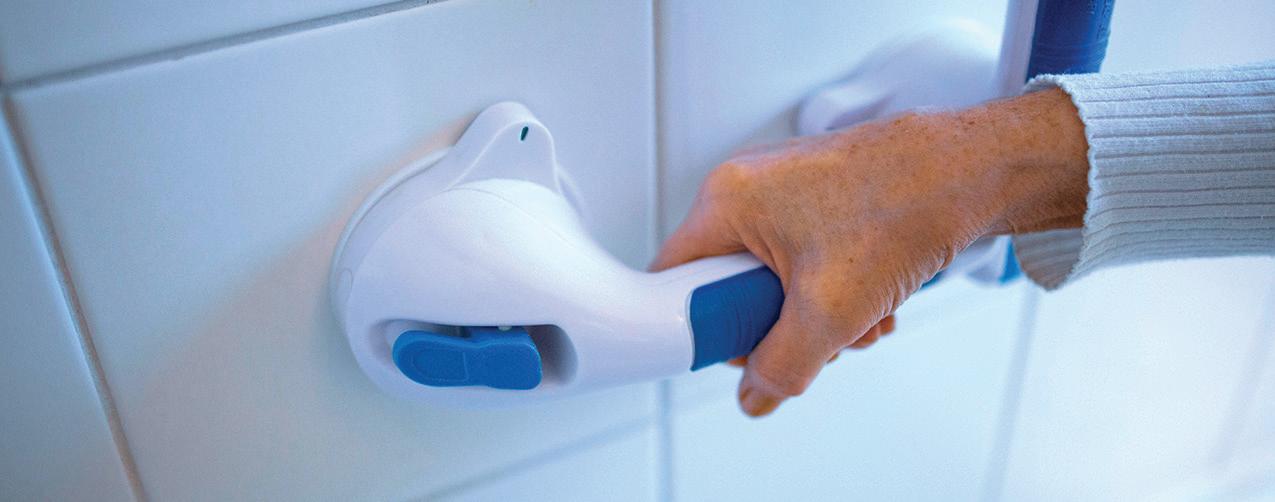
Home is where the heart is. That sentiment may be especially true for seniors who have spent decades living in their homes. A lot of hard work goes into home ownership, and seniors who have lived in the same space for a while undoubtedly have countless memories within the walls of their homes.
A lifetime of experiences in a home can make it hard to leave, but many seniors experience diminished mobility as they age. Mobility issues can make it hard for seniors to traverse their homes, but aging homeowners can make various renovations to make a home more accessible.
• Revamp entryways and staircases. A 2020 study of 1,000 adults in the United Kingdom found that 28 percent of individuals age 65 and older who don’t exercise regularly struggle with activities like walking up stairs. The study, commissioned by Total Fitness, also found that 14 percent of men and women over 65 who regularly engage in moderate exercise still find it challenging to climb up and down a flight of stairs. Seniors facing similar challenges can install a ramp at their home’s entryway so they can comfortably go in and out. Inside, a chair lift can ensure seniors are not struggling to move from one floor to another.
• Raise the outlets throughout the home. They’re easily overlooked, but outlets, particularly those outside the kitchen, tend to be close to the floor. AARP notes that’s no accident, as outlets are generally placed at a height equal to the length of a hammer to save time with measuring when buildings are being constructed. Outlets close to the floor can be difficult for seniors with mobility issues to reach. Relocating the outlets a little higher off the

Randal Caldwell and Antonia Sicilia are co-authors of the latest treatise for attorneys on Iowa Estate Planning, including Estate Administration, Wills, Trusts, Advanced Directives and Elder Law. Presented by Lexis-Nexis publishers.
Caldwell & Brierly, PLLC www.lawyeriniowa.com 211 1st Ave. W., Newton, IA 50208 Call 641-792-4160 for an appointment.


floor is not an expensive renovation, but it can make a home more accessible for seniors who have difficulty bending down or getting down on one knee.
• Install door knob extensions. Verywell Health notes that nearly half of all people age 65 and older have arthritis or another rheumatic condition. Arthritis can make it difficult for seniors to grip and turn door knobs. Door knob extensions can make it easier for seniors with arthritis to open the doors in their homes. Such extensions are roughly five-inch levers that can be installed over an existing door knob, making it easier to grab and pull down. Extensions save seniors the hassle of turning the knob, which some may find painful and almost impossible.
• Renovate the bathroom. Bathroom renovation projects can be costly, but seniors with mobility issues should know that bathrooms can pose a particularly dangerous threat. The Centers for Disease Control and Prevention notes that roughly three million older adults are treated for fall injuries in emergency departments each year. A 2019 analysis published in The Journals of Gerontology noted that 22 percent of in-home falls resulted in a change in the person’s walking ability. Replacing a step-over shower with a zero-step alternative can make it easier for seniors with mobility issues to get in and out of the shower, thus reducing their risk for falls. Grab bars along shower walls and a chair inside the shower can make it easier to bathe and towel off safely.
Seniors with mobility issues can make their homes more accommodating through an assortment of simple, yet effective renovations.
Metro Creative
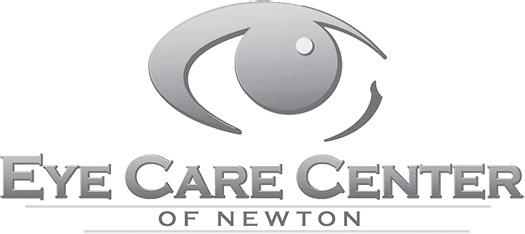
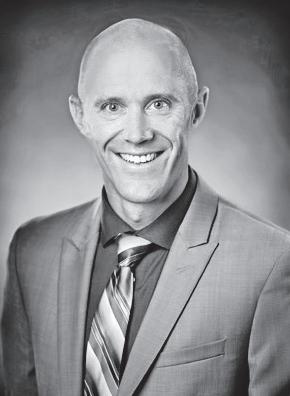




Caregivers come from all walks of life. Doctors and nurses may be the frontline medical providers people encounter most frequently, but there are plenty of others who do their part to maintain the well-being of individuals, including home health aides.
Home health aides, sometimes called personal care aides, are brought in to assist a person with activities of daily life. An HHA typically helps a person who may need some assistance with tasks they cannot perform due to illness or disability. HHAs may work in a person’s home, in a group home or in another care facility.
AARP says home health aides are considered health care paraprofessionals and must meet established training requirements, which vary by location. HHAs may perform various duties, including:
• assistance with personal care, such as dressing, toileting, feeding, and moving from bed to chair, etc.
• checking vital signs
• monitoring a client
• light housekeeping
• meal planning and cooking
• picking up prescriptions
• companionship
HHAs typically will not provide skilled nursing care and may not be able to offer recommendations on treatment or medications.
Individuals can find the services of HHAs who may work independently or are placed through agencies. Sometimes a doctor or hospital will have connections to HHA services and can make referrals. It can be useful to interview several potential HHAs to find one who will fit with the needs and personality of the person requiring assistance. A good HHA will be compassionate, patient and flexible. As illness or injury also can affect a person’s mood, HHAs must be able to adjust if a client is reluctant to receive help or is depressed or anxious from his or her limitations.
Home health aides serve vital roles in the health care community by providing care and companionship to those who can no longer live independently.
— Metro Creative

A desire to live independently seems to be part of human nature. Though that desire may continue to burn as individuals approach retirement age, unforeseen circumstances like medical issues or the death of a partner may result in a need to work with a professional caregiver.
Home health aides (HHAs) can help aging individuals or those with certain physical or cognitive limitations live full lives without requiring them to move into assisted living facilities or seek alternative housing arrangements. HHAs provide a host of services, and individuals living in well-populated areas may have no shortage of options as they seek to hire a professional to help themselves or a loved one with the tasks of daily life. Individuals or families beginning their search for a home health aide can keep these tips in mind.
• Identify the services required. The Family Caregiver Alliance® notes there are several main areas to assess when identifying which services individuals may need help with. Personal care consists of bathing, eating, dressing, toileting, and grooming. Household care involves cooking, cleaning, laundry, and shopping. HHAs who provide medical care may help clients manage medications, provide physical therapy and help clients get to their doctor’s appointments. Companionship is a component of emotional care, which also may entail engaging clients in meaningful activities and conversation. Identifying the services required can help individuals and their families zero in on the professionals who can help them.
• Seek recommendations from trusted doctors and confidantes. An individual who needs daily assistance at home can ask his or her physician for recommendations (family members can ask as well).





Physicians undoubtedly have had previous patients who have benefited from the services of HHAs, so they can likely recommend local professionals. Trusted confidantes, such as neighbors, relatives and friends, who have been in similar situations, or have family members who have required HHAs, also can be an invaluable resource.
• Contact a local agency. The FCA notes that contacting a local Home Care Agency is a formal way to find an HHA for yourself or a loved one. Various agencies are likely in operation within a reasonable distance of a person’s home, though the FCA notes far fewer agencies serve rural areas. Contacting a local Home Care Agency can put individuals and their families in contact with professionals who can help match people with particular needs with HHAs who specialize in such care or have extensive experience providing a range of home care services.
• Look into a direct-hire group. AARP® notes that direct-hire agencies maintain networks of independent caregivers and facilitate connections between those professionals and individuals and families seeking help. When working with a direct-hire group, inquire about their fees and ask if they can share any information regarding how to pay independent contractors who can be found through their agencies. It’s also important to ask if direct-hire groups formally vet professionals that can be found through them or if individuals and families must conduct their own background checks.
Individuals who need some assistance with daily living can employ various strategies to find home health aides who can provide such services.



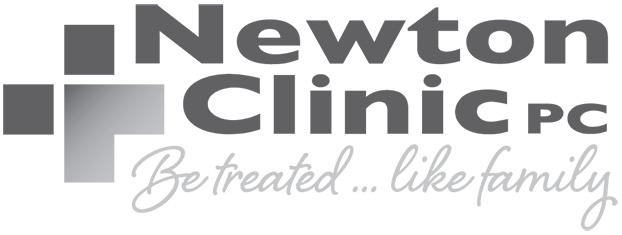
Being in good health and avoiding various diseases often comes down to a combination of factors. Individuals may be aware that nutrition and exercise play important roles in personal well-being, but it appears that nature may provide its own medicinal benefits as well.
A number of studies have examined the potential healing components of being in nature. The World Health Organization released a report in 2023 titled “Green and Blue Spaces and Mental Health,” which indicated that time in nature improves mood, mindsets and mental health. This occurs regardless of whether that nature was “country” regions or urban areas. The following are some of the ways nature can have a healing effect.
• Immunity protection: Trees and plants emit aromatic compounds called phytoncides. When inhaled, these compounds can ignite healthy biological changes similar to the concepts of aromatherapy. When people walk in forests or other green areas, they often experience changes in the blood that are as-

sociated with protection against cancer, improved immunity and lower blood pressure, says Dr. Qing Li, a professor at the Nippon Medical School in Tokyo.
• Get a brain break: When spending time in nature, attention is focused on the scenery,
the animals and the rest of the environment. This may help quiet the rush of thoughts in the head that clutters the ability to think freely.
• Reduce stress: Stress is a catalyst for a number of adverse health conditions. The Mayo
Clinic says stress can cause headache, muscle tension, fatigue, changes in sex drive, and a weaker immune system, among other things. Being outside in nature and away from work and home responsibilities can help reduce stress levels. Dr. Mathew Mc-
Glothlin, senior medical director with WellMed Medical Group, says being in nature provides stress relief.
• Get vitamin D: The body naturally produces vitamin D from sun exposure. The National Institutes of Health says it is optimal to have sun exposure for five to 30 minutes a day, most days a week, to absorb UVB rays and effectively make vitamin D. Vitamin D is a nutrient the body needs to build and maintain strong bones. Vitamin D also regulates many other cellular functions in the body, and may be able to prevent cognitive decline.
• Inspires exercise: People may be more inclined to be physically active while outdoors. Hiking, cycling, swimming, and even strolls in the park all make the outdoors more fun. Exercise promotes heart health and helps people maintain a healthy weight.
Nature can have a healing effect, and more time outdoors can promote mental and physical well-being. — Metro Creative

Healthy eating is important at any age and can set the course for a life of vitality and wellness. Sufficient nutrition can help prevent chronic illnesses and make sure that growing bodies develop properly. As one ages, various changes take place in the body, making healthy eating even more essential.
According to Healthline, nutritional deficiencies can effect aging individuals, which can decrease quality of life and lead to poor health outcomes. Individuals should pay attention to their vitamin and mineral intake at various ages so they do not miss out on important nutrients. As a person ages, here are some approaches to consider.
• Consume fewer calories: According to Connie Bales, PhD, RD, associate director of the Geriatric Research, Education, and Clinical Center at Durham VA Medical Center, people need fewer calories every decade.
That’s because individuals are moving around less and have less muscle. This causes a decline in metabolic rate.
• Include more nutrient-dense foods: Even though caloric needs go down with age, it’s important to pack as much nutrition into the calories a person does consume. That means finding nutrient-rich foods like whole grains, fruits, nuts, beans, vegetables, fish, and lean cuts of meat.
• Consume more lean protein: Muscle loss and loss of strength can develop as a person ages. Healthline says the average adult loses 3 to 8 percent of their muscle mass each decade after age 30. Eating more protein could help aging bodies maintain muscle.
• Eat fortified cereals and grains: The ability to absorb vitamin B12 can decrease as one gets older and with the use of certain medicines. Many health professionals recommend patients get
more vitamin B12 by consuming foods enriched with this vitamin. Vitamin supplements may be needed in addition to food.
• Drink more fluids: Health.com says sensation of thirst declines with age. Drinking water and other fluids becomes a priority to stay hydrated. It also helps with digestion.
• Prioritize bone health: Osteoporosis is a concern for older adults, particularly women who have reached menopause. Osteoporosis occurs when
bones become brittle and can break from only the slightest bump or fall, says the Mayo Clinic. Vitamin D and calcium help strengthen bones, and older adults may need more of these nutrients.
Individuals should speak with their health care providers and nutritionists for further insight into their changing nutritional needs. Such professionals can help customize diets to address specific health concerns.




